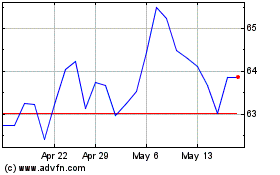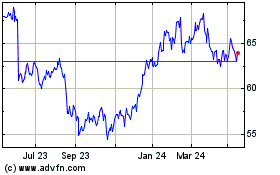Asian Shares Rise on Strong U.S. Lead
06 October 2016 - 3:00PM
Dow Jones News
Asian shares were broadly higher on Thursday, tracking a strong
close in the U.S. equity market and solid U.S. economic data that
saw the yen weaken.
The Nikkei Stock Average was up 0.7%, as the yen softened
against the U.S. dollar, supporting local exporters. Meanwhile, the
S&P ASX 200 was up 0.3%, the Hang Seng Index was 0.5% higher
and Korea's Kospi rose 0.3%. Markets in China are closed for the
Golden Week holiday.
At the start of Tokyo share trading, the yen weakened about 0.1%
against the dollar. It is now about flat to the greenback.
Late Wednesday, the Institute for Supply Management released its
September survey of demand seen by managers of U.S. service-sector
firms. The survey reading jumped to 57.1, hitting an 11-month high
and well above market consensus of 53. The dollar strengthened as a
result, and the WSJ Dollar Index was recently up 0.1% against a
basket of currencies.
"It is very much at the moment all about the U.S. dollar," said
Gavin Parry, managing director at brokerage Parry International
Trading in Hong Kong. "It is impacting the rest of the [Asian]
region."
The weaker Japanese yen supported local exporters, with auto
makers rising: Mazda Motor climbed 3.7%, Toyota Motor rose 1.4% and
Nissan was 0.7% higher.
The share prices of Japanese banks also improved as fears about
Deutsche Bank's health continued to subside. The Topix bank
subsection extended gains for the fourth session in a row and was
last up 2%.
Overnight, U.S. crude-oil prices surged more than 2% after data
showed that U.S. crude stockpiles fell for the fifth consecutive
week. Shares in energy companies led the S&P 500 higher, which
rose 0.4% on Wednesday. WTI slipped back 27 cents in Asian trade,
but was still hovering just below $50 a barrel. Japanese oil
explorer Inpex rose 3.8% and Japan Petroleum Exploration was 3.5%
higher.
Weaker-than-expected U.S. ADP employment data—a survey of
payroll figures—suggested that the U.S. jobs market was softer than
thought.
Companies across America added 154,000 workers to their ranks in
September, while economists surveyed by The Wall Street Journal
expected an increase of 173,000.
This has dampened expectations for a U.S. rate increase by
year-end. According to CME Group's FedWatch tool, the likelihood of
a rate rise in December has slipped to 59.8% from 63.4% a day
earlier.
In the short-term, investors will look to the U.S. initial
jobless claims later on Thursday and nonfarm payrolls on Friday,
which should shed more light on the Federal Reserve's rate
stance.
Write to Ese Erheriene at ese.erheriene@wsj.com
(END) Dow Jones Newswires
October 05, 2016 23:45 ET (03:45 GMT)
Copyright (c) 2016 Dow Jones & Company, Inc.
ASX (ASX:ASX)
Historical Stock Chart
From Dec 2024 to Jan 2025

ASX (ASX:ASX)
Historical Stock Chart
From Jan 2024 to Jan 2025
